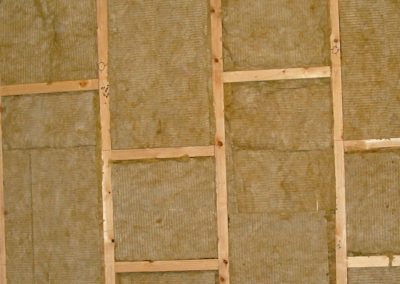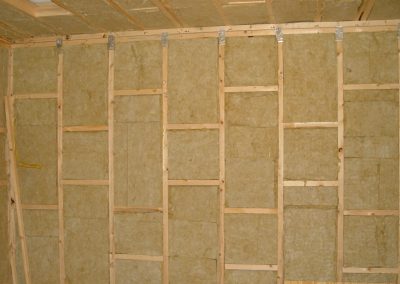By Dan Daley
Tech Living, May/June 2005
The proliferation of affordable home theater systems has created a conflict not unlike that of what happens when civilization encroaches upon the wilderness, except the bear might not limit his actions to banging on the wall. Home theater has increased both the volume and the frequency range of many newer audio systems. Put that power into a smaller space like a condo, and you’re sure to disturb the neighbors.
When people talk about soundproofing a multiunit residential environment these days, it’s almost always code for toning down low frequencies. The subwoofer that’s part of every home theater system, as well as more than a few stereo systems now (Bose’s classic 2.1 cube speaker systems really drove subs into homes before video did), has added a third, very assertive dimension to residential acoustics. It’s the low-frequency effects (LFE) channel-the “point-one” in 5.1- and 7.1-surround speaker systems-that has been shaking the rafters of condos and apartments that own them and, increasingly, the ones next door, too.
FEEDING THAT FREQUENCY
The very nature of the low-frequency wave makes it the aural equivalent of a brontosaurus: huge and lumbering. A 50-Hz sound wave requires over 22 feet to fully unroll; a 30-Hz wave needs nearly 38 feet. Virtually nothing stops bass frequencies at high output levels.
Low frequencies can be tamed, but it takes know-how, planning and effort. The main strategies of bass management are containment and isolation. Isolation calls for the surfaces immediately affected by low frequencies to be decoupled from any other aspect of the structure they’re housed in. That means building a room within a room in which the interior walls are “floated” from the rest of the structure.
Containment comes by sealing every possible air passageway out of the theater, because low frequencies propagate through any type of portals between surfaces. Door seals are particularly important-foam or neoprene moldings work well and there are door designs that utilize spring-loaded sealing mechanisms that engage automatically when the doors close. Also, most homes still use hollow-core doors and switching to a solid-core door can make a huge difference.
THE WALL
Home theater designer Carl Tatz, of Carl Tatz Design in Nashville, Tenn., lives in a 12-story condo on a bluff overlooking the city and has constructed a floating wall to mute his own home cinema. Here’s his step-by-step: “Build a two-by-four-stud wall that will sit between a half-inch and an inch from the original wall and whose footer rests on a half-inch closed-cell neoprene strip. The same kind of strip goes between the wall’s header and the room ceiling. On the sides, get the outer studs as close to the room’s walls on either side without actually touching them. Fill in between the studs with eight-pound rock wool. The first layer of the new interior wall is 5/8-inch sheetrock, followed by a half-inch layer of plywood. Add another layer of sheetrock. Then seal the ends of the wall with acoustic caulk, which never completely dries and avoids a rigid connection. ”
Tatz says the goal is twofold: “No rigid mechanical connection between the new wall and the old, and to create resonant surfaces using a combination of materials that will let the bass frequencies dissipate themselves over them,” he says.
There are also specialized products available for bass containment. Super Soundproofing has a showroom in San Marcos, Calif. Several products aimed at bass management, including mass loaded vinyl sheets made by manufacturers including Acoustiblok and Technifoam, act like lead to help attenuate low-frequency transmissions as much as 26 STC points. Acoustiblok also makes closed-cell foam, whose cellular construction helps contain bass. Super Soundproofing makes its own vibration pads, comprised of a cork center wrapped in a layer of neoprene, which can be placed under the comers of subwoofers.
The number of contractors that specialize in noise control, while still relatively small, is growing as awareness of noise increases. When all else fails, though, the solution of last resort is the now-discontinued $59.99 Bilsom headset, which is specifically tuned to help cancel out bass frequencies.
ALL ALONG THE SPECTRUM
Other-frequencies in the spectrum are less daunting to handle. If you have addressed bass with any of the mechanical solutions mentioned here, chances are you’ve also dealt with midrange and high-frequency noise transmission in the same process.
However, not all home theaters emphasize the bass-theater setups in children’s rooms, for example; tend to be less bombastic in general than the main family theater. If noise covers a great range of frequencies-the midrange centering on 1 kHz where a lot of film dialog resides tends to be particularly penetrating of wallboard-look first for air pathways between rooms or units. Check the electrical outlets too; the plates are probably perfectly lined up on either side of the wall because that made the most sense when the building was being constructed. One solution is Good Stuff; an industrial foam sold at Home Depot and other hardware outlets, which can be used to fill the cavities around outlets and other wall- and floor-mounted appurtenances like vents and lighting panels. Acoustical caulk, a bit more esoteric and found at specialty construction material outlets, is also useful because it’s designed to never completely harden, giving anything it seals the “floppiness” needed to absorb sound rather than transmit it.
There are acoustical panels available that can be used to minimize diffusion and to increase absorption of sound in the theater room. However, they tend to have a paradoxical effect: by reducing sonic reflections in the room, the panels actually make sound more articulate at lower volumes, but the improved sound also has the tendency to seem better at higher volumes, because the acoustical artifacts created by reflections have been mitigated. Acoustic Sciences Corp. makes an entire soundproofing kit for apartments; products are also available from Acoustical Solutions and RPG, among others.
Expect condominium and co-op boards to begin addressing the issue of home theater noise in their buildings in the very near future. To the extent you can anticipate that kind of regulation and prepare for it, you’ll be creating the ultimate requisite for high-density living: a good neighbor policy.



